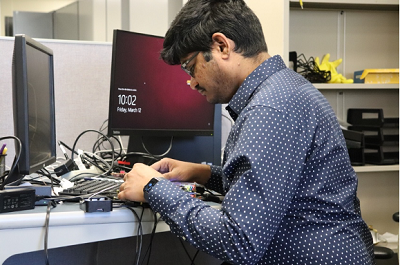Safe and Secure
Dr. Prasanth Yanambaka, a faculty member in the School of Engineering & Technology, recently received an award for the second-best paper of 2020 by the IEEE Consumer Electronics Magazine for his research on device and data security. Dr. Yanambaka and his co-authors propose the integration of a unique blockchain, a database that stores information, that can be used to ensure the privacy and integrity of data collected from medical devices.
Blockchain was first introduced in the finance world and has since been used in fields such as real estate, agriculture, and healthcare. Curious about blockchain’s application in the healthcare field, Dr. Yanambaka and his co-authors focused their attention on wearable or implantable medical devices, such as Apple watches and pacemakers.

As the number of internet-based devices increase, so does the threat of security attack. Blockchain is used throughout the internet to help maintain security and prevent these data attacks. Blockchain stores data in blocks that link together. Everyone in the network can see the data in the blockchain. If the information in one block changes, so does the hash value (its numerical identifier) for that block. While hash values help track changes in the data by revealing which block in the sequence was altered, various internet-based devices are still vulnerable to unauthorized data disclosure, destruction, and loss.
To help improve these issues and preserve the privacy of patients using wearable or implantable medical devices, the research team proposed the development of PUFChain. PUFChain is a secure database that integrates physical unclonable functions (PUFs) with a blockchain to collect and share data. First, a device is assigned a unique identification number. Then, any new data collected from the user, via the device, is added to a block. This block makes up part of the PUFChain, which is filled with data blocks from other devices in that network. Data in the PUFChain cannot be extracted unless the client inputs the correct PUF keys for a given block. When required, unique and unclonable keys are generated by the PUF, making the data in the chain extremely difficult to access without permission.
After testing the capabilities of the proposed blockchain, the research team confirmed that PUFChain can help in preserving the privacy of those who use wearable or implantable medical devices.
At CMU We Do Research, We Do Real World
Story by ORGS intern Hailey Nelson
August 2021